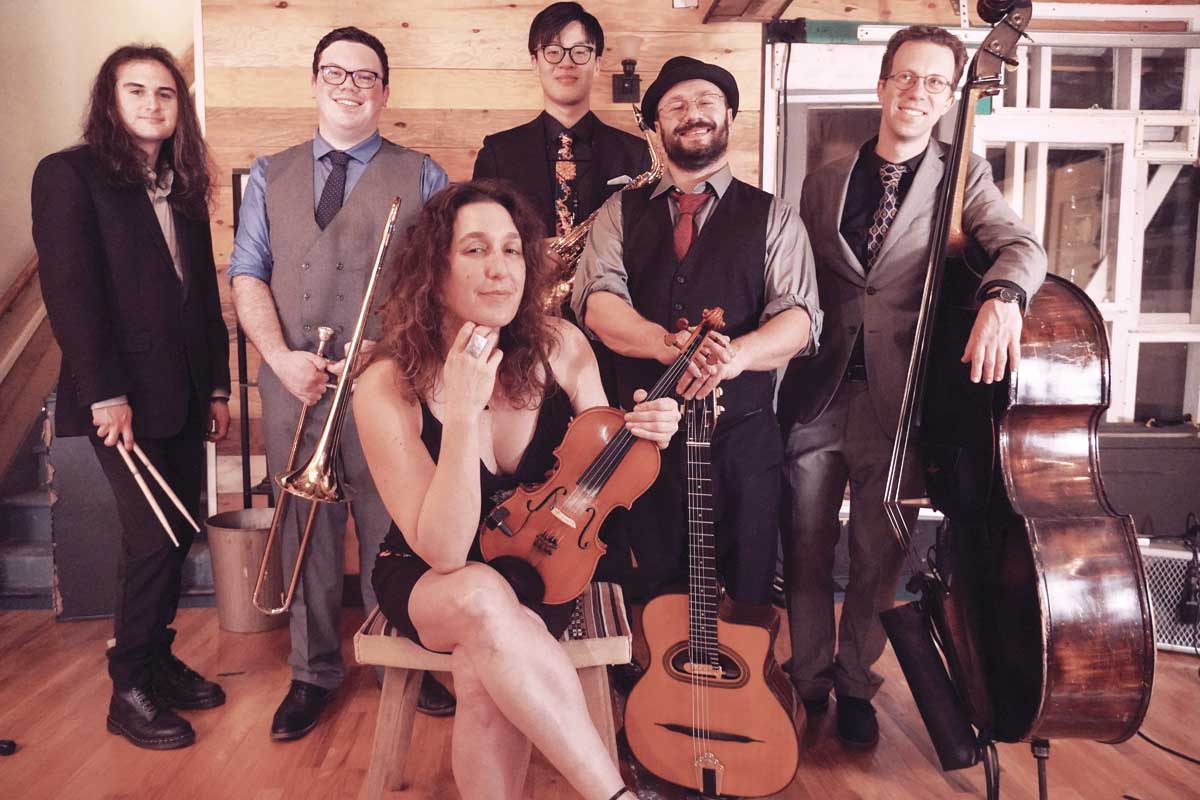It was a night to remember, because I certainly do. Mystic Theater, 1997.
The 14 members of Marin-based Lee Press-On & The Nails, led by a short singer-bandleader akin to the character Beetlejuice, take the stage before a curious audience with no idea what’s about to happen to them.
Loud, fast and slightly out-of-tune music in a minor key commences, but it’s not heavy metal. A handful of groupies from the Bay Area who follow the band everywhere—even to Petaluma—begin dancing, and not just hokey moves they learned from their grandmother, but wild Charleston kicks straight outta Harlem, and every manner of jump, flip, splits and slides across the floor.
Sonoma County watched in disbelief, and I said to myself, “I need to learn this.”
I did, and became an expert in swing music and dance practically overnight, which happens when you’re prone to obsessive enthusiasm, and with something as downright positive as swing. I began teaching in a Santa Rosa studio, hosted a weekly swing night in Railroad Square and wrote a cover story for this very newspaper on what has now gone down in the annals of history as the “late-’90s swing revival,” which, thanks to its national epicenter being neither New York nor Los Angeles but San Francisco, swung its way up to the sticks of Sonoma County.
Back then, The Mystic Theatre and a slew of other venues regularly hosted such pioneering Bay Area acts as Indigo Swing, Stompy Jones, Steve Lucky & The Rhumba-Bums, Lavay Smith & Her Red-Hot Skillet Lickers, Mitch Woods & His Rocket-88s and others. They certainly had a flair for catchy names.
Our hometown band in Santa Rosa was the more simply named Savoy Swingers, and our little suburban scene—that’s right, back in the days of music and fashion tribes and “scenes”—snatched a wide spectrum of enthusiasts. It was a time when former band geeks who played the trombone in high school and disillusioned punk rockers formed an unlikely alliance, trading in Doc Martens for vintage wingtips and banding together to rescue the one truly great American art form, jazz music and dance.
And now the pendulum has swung back, and Santa Rosa is once again hosting live music and dancing at The California, where on the third Tuesday of each month the newly formed, Marin-based Death And Taxes Swing Band, led by vocalist—and violinist—Rebecca Roudman takes the stage with a free dance lesson beforehand. The next show swings into town May 21.
What will they play, of the thousands of possible tunes from the Great American Songbook that can be swung? “What we play are 100% personal selections, songs we grew up hearing around the house, which we give fresh new arrangements,” said Roudman.
Those arrangements come in a variety of tempos for the band formed only a year ago. And one of Roudman’s greatest joys is performing before a swirling, swinging dance floor. “We know what dancers want to dance to, and that’s not just one tempo the whole night. My favorite part about this band is watching the people dance, and it’s hard not to get distracted,” she explained.
Infectious is a good term to describe the vibe produced by swing, the literal musical meaning of which is a particular rhythm best described as dotted eighth-notes. Though terms and styles varied—swing, jump blues, lindy hop, jitterbug—they all sprung from the same tree, and represented the great cultural exchange of black and white America. The swing era from 1935-1945 lasted longer than other music-dance-fashion fads before or since, from the Charleston to the British Invasion to disco, which typically lasted about three years—about the same as the late ’90s swing revival.
Although the first young archeologists began digging up jitter-bones in the late ’80s, and the music and dance are at the heart of the 1993 film, Swing Kids, set in Nazi Germany, most pop culture historians would say the trend began with the 1995 indie film, Swingers, which features a climactic dance scene with Jon Favreau and Heather Graham.
Soon came the “khakis swing” TV commercial for The Gap, the Top 40 hits “Zoot Suit Riot” by Cherry Poppin’ Daddies and “Jump, Jive & Wail” by the Brian Setzer Orchestra, and a wild number by Royal Crown Review in the Jim Carrey film, The Mask. The Squirrel Nut Zippers were another pioneering band on the national scene, swinging through the Luther Burbank Center in the late ’90s.
At the time, it seemed like every lifestyle publication, daily newspaper and morning talk show jumped on the bandwagon to report on the trend, where a constant refrain was “Looks fun, but do I have to dress old-timey?” The trend peaked with Big Bad Voodoo Daddy playing the Super Bowl halftime show on Jan. 31, 1999, whereupon it disappeared almost instantly from the public eye. This since once something’s reached the visibility of a Super Bowl halftime show, there’s nowhere to go but down.
But the main thing that was achieved in the past 25 years since is that swing was rescued from obscurity and instilled across America as our national dance form, which the Death And Taxes Band and a new generation of young musicians proves.
Recently, the band toured Florida and had a booking in a small town. When they pulled in and told the locals to come to the gig, saying they’d be playing classic big band swing music, they received blank stares and ignorant inquiries. “So we just said, ‘It’s fun, energetic and community building, and it’s not that hard to learn,’” said Roudman. And they got to learn the dance moves from the very band itself, making them all-around preservers of the tradition, as the pre-show dance lesson is taught by bass player Colin Williams.
That’s one major change from the late ’90s. Back in my day, musicians didn’t dance.











